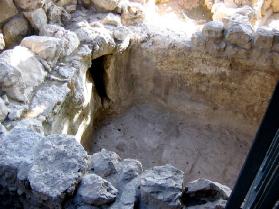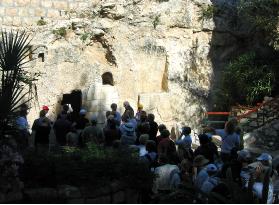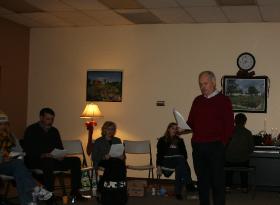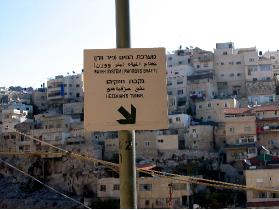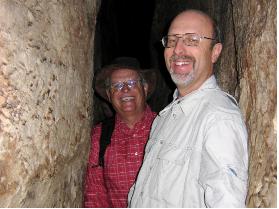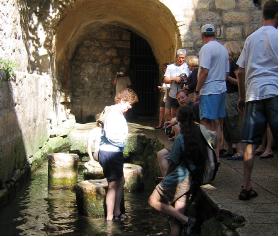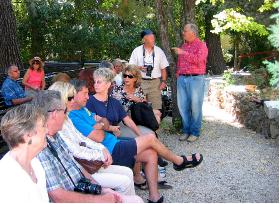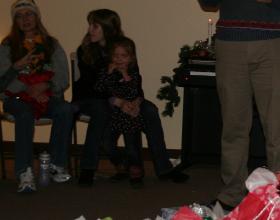 |
|
Israel Journal COLLEEN TINKER |
||||
NUMBER 15 — MONDAY, NOVEMBER 10, 2008
City of David, Hezekiah's tunnel, Garden tomb, and the Western Wall tunnel
City of David
Today was an awesome final day of this tour. Our first appointment was at the City of David. I did not know before this trip that the City of David was not the Jerusalem of Jesus’ day. Tbe City of David, to be sure, was the embryonic Jerusalem, but it was a tiny tongue of land that actually lay outside the city gates on the east side. The Kidron Valley runs right in front of it, and the Mount of Olives rises immediately on the other side of the Kidron Valley.
David’s men actually captured the early Jerusalem from the Jebusites. His general Joab led men through a tunnel that was part of the Jebusite’s water system and crawled under the city gates, entering the city through the mouth of the tunnel. The City of David, early Jerusalem, was by a water source that still, 3,000 years later, produces water: the Gihon Spring.
Within the past very few years (five or less), an archeologist who has had a special interest in finding some of the more obscure, more doubted places, has excavated the foundations of a building situated at the highest spot in the City of David which is believed to be the foundation of David’s palace. There are no ruins under this foundation; it sits on bedrock, and it dates back to 1,000 BC. Close by is another excavation—not yet complete but revealing a cross-section of building layers that, at the bottom, dates back to 1,000 BC. In the pile of stones there was an ancient stone with a hole in it: a toilet seat. (For real!)
Hezekiah’s Tunnel
From the excavation of David’s palace we commenced an amazing adventure: we descended a very deep shaft to Hezekiah’s tunnel. Hezekiah, about 800 BC, decided that he wanted the city’s water supply to be protected from the enemy. Jerusalem was still using the Gihon Spring for water, but the spring was outside the city. People (uh—read that the women) of Jerusalem had to go to the spring via a tunnel that went under the city wall and carry it back. This arrangement left the spring vulnerable to enemies, and Hezekiah decided to divert the water supply via a tunnel so the spring water would flow directly under the city walls into Jerusalem and thus be unavailable to anyone outside.
Hezekiah’s tunnel is longer than a football field and is deep under ground. Water still runs through it, and there is absolutely no light. But it is big enough for people to walk through—and we did! It was an amazing and exciting adventure. Right after we entered the tunnel, the flow of the water and the direction of the tunnel created an area where the water was mid-thigh, but as we kept walking, the water leveled out and came a bit over the ankles. The tunnel was narrow; we could only walk single file.
The height varied; I was able to walk upright through most of it, but the men had to duck quite often. At the far end, the tunnel walls suddenly soared overhead like towering cliffs. We carried flashlights, and we could see water seeping through the ceiling and the walls of the limestone. It was an unforgettable experience to walk through that tunnel and to realize that it was about 2,800 years old, that Hezekiah’s men had carved out that passageway, and we were now able to touch the rocks and to walk in the water from a spring that has been producing water for thousands of years. Totally awesome!!
The tunnel exited into the Pool of Siloam. The Pool of Siloam is remembered for Jesus’ Sabbath miracle, recorded in John 9, in which he put mud on the eyes of a man born blind. His disciples had asked Him whose sin had caused this disability, and Jesus responded, “Neither this man nor his parents sinned, but this happened so that the work of God might be displayed in his life.” Jesus then placed mud on the man’s eyes and told him to wash in the Pool of Siloam.
The Pharisees were enraged and said, “This man is not from God, for he does not keep the Sabbath.” Others disagreed, saying a sinner could not do such miracles. But the man himself—believed and refused to denounce Jesus.
The Garden Tomb
Our next stop was at the Garden Tomb which commemorates Jesus’ resurrection. It is likely not Jesus’ actual tomb, but it IS a real tomb which excavations have shown to have belonged to a wealthy family in a location very near a well-known crucifixion spot. Even if it is not the real tomb, it is an excellent memorial site. It is located in a beautiful garden—flowers and trees of various kinds create a shady, lovely meditative spot.
After a tour of the garden and the tomb, we gathered in a shady spot and celebrated communion together. We opened by singing “Wonderful, Merciful Savior”, and before we finished, the amplified blare of the midday Muslim call to prayer filled the air. We finished the song, and over the disturbing noise of the Muslim chanting Gary said (in essence), “Part of our reality is competing with the noise of the world. As Christ-followers we become islands of truth in the darkness. This is the reality of our calling; we have to proclaim the truth without being intimidated by the noise around us.”
The by-the-clock call to prayer ended, and Gary read the resurrection story from the book of John. One insight that especially impacted me was Gary’s comment about the underlying meaning of the word “saw” in John 20:8, where John and Peter went to the empty tomb. They found the grave clothes “lying there” (the Greek here suggests they were undisturbed, that Jesus had left them without unwrapping them). John, verse 8 tells us, “saw and believed”. The word “saw” is a word which suggests an “a-ha”—a flash of insight in which John “got it” and KNEW Jesus had risen from the dead in an impacting way.
Michael Hicks sang “In Christ Alone”, and then we shared communion together, drinking the wine out of olive wood communion cups which we were able to keep when we were done. Several people shared what was impacting them about what Jesus has done, and then Gary turned to Romans 4 and said one of the great truths in Scripture is the substitution of Jesus. He took God’s wrath so it won’t fall on us. He said the resurrection has two significant impacts:
- It is God’s vindication of Jesus—it is God’s “Amen” to Jesus’ “It is finished.”
- It is the basis of our vindication before God.
The garden communion was deeply moving—a wonderful culmination of the past two weeks of reflecting on Jesus’ ministry and mission of dying for sin and defeating the power of death.
The Western Wall Tunnel
After a couple of hours for lunch and shopping, we went to the Western Wall as a group. After experiencing the Jews’ prayers that seem to go on perpetually there, we walked through a recently excavated tunnel that parallels the entire length of the Western Wall.
The Western Wall of the temple mount is the most sacred place in Israel to the Jews. It is the surviving part of the temple complex that stood closest to the Holy of Holies, and Jews believe the Spirit of God dwells at the Western Wall in a particular way because of its proximity to the destroyed Holy of Holies that stood on the temple mount. Only a small portion of the wall is accessible today, however.
Most of the Western Wall has been hidden from view for centuries by the Muslim Quarters which were built against it. In 1967 the Israeli Ministry of Religious Affairs launched a project to expose the full length of the Western Wall. They accomplished this project by engineering a tunnel that ran under the Muslim Quarter and paralleling the entire length of the Western Wall. We walked through this tunnel, seeing the original Herodian building stones that formed the foundation of the wall. The lower stones are enormous; one of the larger ones measures about 44 feet in length and is estimated to weigh over 160 tons.
The lowest level of the wall was constructed out of the natural bedrock, not from individually shaped stones. The bedrock, however, was carved to match the stones above it. The tunnel turns at the end of the wall and continues through an ancient aqueduct used during the Hasmonean period to provide water to the temple mount.
The day ended with a banquet for our tour group including our guides and bus drivers. All of us feel tired but happy, changed in significant ways because of this time seeing the Bible from the perspective of the land. Most of our group are already on their way to the airport. Eighteen of us, however, leave tomorrow morning at 7:15 to catch our flight home.
This has been an amazing, wonderful, perspective-changing two weeks. I pray God will continue to teach me truth and to root me in reality, helping me to see as He sees, know as He knows, and love as He loves.
I’ve gotta go pack…
Copyright 1999-2008 Graphics Studio, Redlands, CA USA. All rights reserved. Revised November 17, 2008. Use of this site and forum signifies your acceptance of the Terms and Conditions. Send comments and questions to formeradventist@gmail.com
